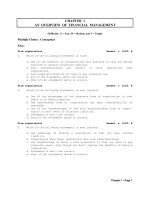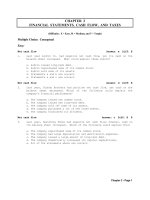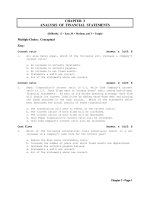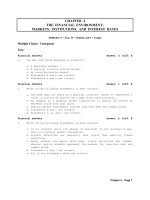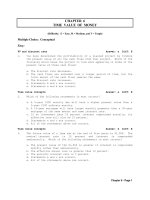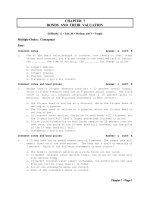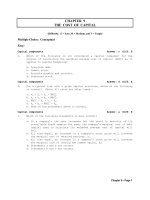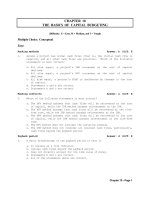Test bank accounting management 11e chapter 17 PROCESS COSTING
Bạn đang xem bản rút gọn của tài liệu. Xem và tải ngay bản đầy đủ của tài liệu tại đây (193.2 KB, 14 trang )
CHAPTER 17
PROCESS COSTING
LEARNING OBJECTIVES
1. Identify the situations in which process-costing systems are appropriate
2. Describe the five steps in process costing
3. Calculate equivalent units and understand how to use them
4. Prepare journal entries for process-costing systems
5. Use the weighted-average method of process costing
6. Use the first-in, first-out (FIFO) method of process costing
7. Incorporate standard costs into a process-costing system
8. Apply process-costing methods to cases with transferred-in costs
CHAPTER OVERVIEW
Chapter 17 presents a system of costing a product or service in which the cost assignment is more
allocation, an averaging, than tracing of costs. The costing system should reflect the underlying process
leading to the product or service, and process costing does just that—the process forms the basis of the
costing system.
Process costing is appropriate when a common process or series of similar processes produce relatively
homogeneous products. Process costing and job costing are viewed as the two ends of a continuum of
costing systems: from products produced through almost identical processes to a job that yields a
distinctly identifiable product. The accounting system supporting the manufacturing operation must be
designed in a way that captures the underlying process. The chapter gives examples and illustrations of
the accounting required for process costing. A hybrid system of costing, operation costing, is also
illustrated in the appendix to the chapter.
The visual approach to demonstrate process costing used in this text is student oriented. A five-step
procedure is described in the chapter and illustrated through exhibits. The five steps are clear and
straightforward, incorporating inventory flow. The five-step process used in the text for developing costs
in process costing has several excellent features. The first step is simple but sets the pattern followed
throughout the remaining steps: to account for and accounted for categories. The first two steps pertain
only to units, both physical units and equivalent units. Costs are considered only after the units are
clearly identified. Step 3 begins the calculation of the inventory cost flow to be used, allowing for a clear
determination in connecting costs with equivalent units calculated in Step 2. Steps 4 and 5 use the
categories established in Step 1 (to account for and accounted for) but for costs rather than units. Two
separate steps are used, one for each category. The feature of having units identified in the first two steps
before looking at costs is a plus.
Process costing
227
CHAPTER OUTLINE
I.
Costing systems
A. Types
1. Job costing: cost object is a job that constitutes a distinctly identifiable product or service
2. Process costing: process forms basis of costing system
B. Principal functions
1. Determining the cost of products or services that aid in planning decisions such as pricing and
product mix
2. Valuing inventory and cost of goods sold for external reporting
3. Controlling and evaluating performance (not emphasized in this chapter)
II. Basics of process costing
Learning Objective 1:
Identify the situations in which process-costing systems are appropriate
A. Appropriate use of process costing: unit cost of a product or service obtained by assigning total
costs to many identical or similar units [Surveys of Company Practice]
1. In manufacturing, each unit receives same or similar amount of direct materials costs, direct
manufacturing labor costs, and indirect manufacturing costs
2. In computing product unit costs, total costs incurred divided by number of units of output—
same average production cost per unit
3. In comparison to job costing, the extent of averaging is main difference
4. In mass production of product units, similar or identical units of product or service processed
B. Factors in computing product costs
1. Costs separated into cost categories according to when costs introduced into the process
a. Each cost item assigned to category identified by when added to the process
i.
Beginning of process (includes different kinds of costs but all added at start)
ii. Evenly through the process (includes different kinds of costs but all added evenly)
iii. Different times within the process
228 Chapter 17
2. Presence of ending inventories (zero beginning inventory)
a. Zero beginning/ending inventory: all units started and completed in accounting period
i.
Average costs for accounting period calculated from dividing total costs by total units
produced
ii. Situation common in service-sector organizations
b. Zero beginning inventory but some amount of ending inventory:
i.
Costs of partially assembled units not same as fully assembled units
ii. Accuracy of completion estimate depends upon care, skill, and experience of
estimator and nature of conversion process
Learning Objective 2:
Describe the five steps in process costing
3. Steps to calculate costs with some fully assembled units and some partially assembled units
in process costing
a. Step 1: Summarize the flow of physical units of output [Exhibit 17-1]
i.
Tracks physical units of output –whether complete or incomplete
ii. Categorizes units to account for (Where did the units come from?) and units
accounted for (Where did the units go?)
Learning Objective 3:
Calculate equivalent units and understand how to use them
b. Step 2: Compute output in terms of equivalent units [Exhibit 17-1]
i.
Measures output as fully assembled and partially assembled from physical units
ii. Equivalent units: derived amount of output units that
•
takes the quantity of each input (factor of production) in units completed or in
incomplete units of work in process, and
•
converts the quantity of input into the amount of completed output units that
could be made with that quantity of input
iii. Calculates equivalent units for each input (cost category based on timing of costs
introduced into process )
c. Step 3: Compute equivalent unit costs (Steps 3, 4, and 5 together are production cost
worksheet) [Exhibit 17-2]
Process costing
229
i.
Determine cost incurred for work done [Exhibit 17-2]
ii. Divide sum of cost of each input by related quantity of equivalent units of work done
d. Step 4: Summarize total costs to account for [Exhibit 17-2]
e. Step 5: Assign total costs to units completed and to units in ending work in process
i.
Provides summary of costs accounted for (parallel to units accounted for)
ii. Equals total of costs to account for [Exhibit 17-2]
iii. Attaches dollar amounts to equivalent output units for each input-cost category to
units completed and units not yet completed (ending work in process) [from Step 2]
by multiplying equivalent units by cost per equivalent unit [from Step 3]
Learning Objective 4:
Prepare journal entries for process-costing systems
4. Journal entries for process costing [Exhibit 17-3]
a. Similar to entries made in job-costing systems with respect to direct materials and
conversion costs
b. Main difference is one Work-in-Process account for each process rather than each job
5. Presence of beginning inventory and ending inventory—requires choice of cost-flow method
which produces differing amounts for cost of units completed and for ending work in process
Assign Exercises 17-16, 17-17, and 17-18.
II. Inventory-flow methods and process costing
Learning Objective 5:
Use the weighted-average method of process costing
A. Weighted-average process-costing method: calculates equivalent-unit cost of all work done to
date and assigns this cost to equivalent units completed and transferred out of the process and
those in ending work-in-process inventory
1. Step 1: Summarize the flow of physical units of output [Exhibit 17-4]
a. Units to account for are sum of units in beginning work in process and of units started
during the period
b. Units accounted for are sum of units completed and transferred out and of units in ending
work-in-process inventory
2. Step 2: Compute output in terms of equivalent units [Exhibit 17-4]
a. Weighted-average method merges equivalent units in beginning inventory with
equivalent units of work done in current period [to account for] because concern is work
done to date (stage of completion of current-period beginning work in process is
irrelevant)
b. Weighted-average method keeps separate equivalent units of completed and transferred
out from ending work in process [accounted for]
230 Chapter 17
3. Step 3: Compute equivalent unit costs [Exhibit 17-5]
a. Cost of work done to date (sum of costs of beginning work-in-process inventory plus
costs of work done in current period) divided by total equivalent units of work done to
date
b. Cost per equivalent unit is weighted-average cost for each input-cost category
4. Step 4: Summarize total costs to account for (same as cost of work done to date in Step 3)
[Exhibit 17-5]
5. Step 5: Assign total costs to units completed and to units in ending work in process
a. Costs assigned to equivalent units completed and transferred out—for each input-cost
category, equivalent units multiplied by weighted-average cost of equivalent unit
b. Costs assigned to equivalent units in ending work in process by multiplying equivalent
units within each input-cost category by weighted-average equivalent unit cost for that
category
Do multiple choice 1-3.
Assign Exercises 17-19, 20, and 17-24 and Problems 17-30 and 17-31.
Learning Objective 6:
Use the first-in, first-out (FIFO) method of process costing
B. First-in, first-out (FIFO) process-costing method: calculates and separates cost according to
order of time periods in which the work was done (ordinal number of “first”)—work done on
beginning inventory before the current period is kept separate from work done in current period
1. Step 1: Summarize the flow of physical units of output [Exhibit 17-6]
a. Units to account for is same regardless of inventory flow method
b. Units accounted for are subdivided by time period in which work is done
i.
Completed and transferred out during current period
•
Started in prior period (beginning work in process) and completed this period
•
Started this time period and completed this period
ii. Work in process, ending (started this time period but not completed this time period)
2. Step 2
a. Equivalent units calculated only for work done during current period for each input-cost
category, includes
i.
Work done to complete units in beginning work-in-process inventory
ii. Work done to complete units started this time period
Process costing
231
iii. Work done on units started this time period but not completed
b. No equivalencies calculated for work done in prior period
3. Step 3: Compute equivalent unit costs—only costs for each input category added in the
current period divided by equivalent units for each input-cost category of work done in
current period [Exhibit 17-7]
4. Step 4: Summarize total costs to account for (costs of beginning work-in-process inventory
plus costs added in the current period )
5. Step 5: Assign total costs to units completed and to units in ending work in process
a. Units completed and transferred out assigned costs according to
i.
Beginning work-in-process units assigned costs from costs to account for in
beginning work-in-process
ii. Beginning work-in-process units also assigned costs of costs used to complete them
using equivalent units of work for each input-cost category multiplied by equivalent
cost per unit of work done this period
iii. Started and completed this time period—assigned costs from multiplying equivalent
units of work for each input-cost category by equivalent cost per unit of work for
input category
b. Units in work in process, ending—equivalent units of work for the current time period
multiplied by equivalent cost for corresponding input-cost category of current time period
6. Averages cost transferred in for departments to become modified or departmental FIFO
method rather than pure FIFO
Do multiple choice 4 – 6.
Assign Exercises 17-21, 22 and 17-25 and Problem 17-32.
C. Comparison of process-costing methods
1. Operating income can differ materially between weighted-average and FIFO methods when
two conditions exist
a. If direct materials or conversion costs per unit vary significantly from period to period
b. If physical inventory levels of work in process are large in relation to the total number of
units transferred out
2. Feedback about performance and information for pricing and product-mix decisions can
differ between the two methods
a. FIFO has major advantage of providing managers with information about changes in
costs from one period to the next
b. Weighted average merges unit costs from different periods making comparisons difficult
232 Chapter 17
c. Weighted average has major advantage of simple computations and more representative
average unit cost when large fluctuations of input prices from period to period
3. Activity-based costing less applicable to process-costing environments than job-costing
systems
a. Products are homogeneous and use resources in similar way
b. Cost of activities reduced by controlling costs of individual processes
III. Standard costs and process costing
Learning Objective 7:
Incorporate standard costs into a process-costing system
A. Standards determinable
1. Standards set for quantities of inputs needed to produce output straightforward
2. Standards set for different technical processing specifications for each product
B. Standard costing applicable to process costing
1. Weighted-average and FIFO methods complicated for variety of similar products
2. Weighted-average and FIFO methods yield inaccurate costs for variety of products when
broad averaging of actual costs occurs
C. Standard costing usable with five-step procedure [Exhibits 17-8 and 17-9]
1. Steps 1 and 2 can be same as for FIFO
2. Step 3 uses standard cost per equivalent unit and is therefore not computed in same way as
for actual cost-based weighted-average and FIFO
3. Step 4 debits Work in Process at standard costs rather than actual costs
4. Step 5 attaches standard cost per equivalent unit to assign costs as in FIFO method
D. Variances may be calculated when actual costs incurred in current period do not equal standard
costs assigned to products on basis of work done in current period [Exhibit 17-10]
Do multiple choice 7–9.
Assign Exercises 17-23 and 17-26.
V. Multiple departments and process costing
Learning Objective 8:
Apply process-costing methods to cases with transferred-in costs
A. Transferred-in costs (also called previous department costs) [Refer to Exhibits 17-11 through
17-14]
Process costing
233
1. Transferred-in costs: costs incurred in previous departments carried forward as the
product’s cost as it moves to a subsequent process in production cycle
2. Transferred-in costs are treated as if they are a separate direct material added at the beginning
of the process in successive departments
B. Transferred-in costs and process-costing methods
1. Standard costing: accounting for transfers to successive departments relatively simple
2. Weighted-average method: computations basically same for calculation of equivalent units
except for addition of transferred-in costs [Exhibits 17-11 and 17-12]
3. FIFO method: computations basically same but only costs transferred in during current period
are used with work done during current period [Exhibits 17-13 and 17-14]
C. Accounting for transferred-in costs
1. Remember to include transferred-in costs of previous department
2. Remember to include transferred-in costs in beginning work-in-process inventory costs for
units started in prior period and completed during current period for FIFO
3. Remember that when units are transferred, they are costed at one average unit cost under
FIFO
4. Remember that units may be measured in different denominations in different departments
and each department, therefore, should be considered separately
Do multiple choice 10.
Assign Exercises 17-27 and 17-28 and Problems 17-33 and 17-34.
VI. Hybrid costing systems [Concepts in Action]
A. Product-costing systems are best viewed on a continuum between job-costing and process-costing
systems
B. Product-costing systems should reflect the nature of the underlying operations
C. Appendix illustrates a hybrid-costing system—operation costing
CHAPTER QUIZ SOLUTIONS: 1.c
234 Chapter 17
2.a 3.d 4.b 5.d
6.a 7.b 8.c
9.b 10.d
CHAPTER QUIZ
Use the following information for questions 1–10.
Top That manufactures baseball-style hats. Material is introduced at the beginning of the process in
Cutting Department. Conversion costs are incurred (and allocated) uniformly throughout the process. As
the cutting of material is completed, the pieces are immediately transferred to the Sewing Department.
Data for the Cutting Department for the month of February 2003 follow:
Work in process, January 31 - 50,000 units
100% complete for direct materials, 40% completed for conversion costs
actual costs of direct materials, $70,500; actual costs of conversion, $34,050
Units started during February,
225,000
Units completed during February, 200,000
Work in process, February 28 - 75,000 units
100% complete for direct materials, 20% completed for conversion costs
Direct materials added during February [actual costs]
$342,000
Conversion costs added during February [actual costs]
$352,950
1. Assuming Top That uses the weighted-average method to account for inventories, the equivalent units
of work for the month of February are
Direct Materials
Conversion Costs
a.
225,000
225,000
b.
200,000
200,000
c.
275,000
215,000
d.
225,000
200,000
2. Assuming Top That used the weighted-average method to account for inventories, the cost per
equivalent whole unit produced during February is
a. $3.30.
b. $3.55.
c. $3.77.
d. $4.00.
3. Assuming Top That uses the weighted-average method to account for inventories, the assignment of
costs to work in process at the end of February is
a. $300,000.
b. $266,250.
c. $166,525.
d. $139,500.
4. If Top That uses the first-in, first-out (FIFO) method to account for inventories, the equivalent units
of work for the month of February are
Direct Materials
Conversion Costs
a.
225,000
225,000
b.
225,000
195,000
c.
275,000
200,000
d.
200,000
195,000
5. If Top That uses the FIFO method to account for inventories, the costs per equivalent unit for
February are
Direct Materials
Conversion Costs
a.
$1.50
$1.76
b.
$1.83
$1.72
c.
$1.71
$1.81
Process costing
235
d.
$1.52
$1.81
6. Assuming Top That uses the first-in, first-out (FIFO) method to account for inventories, the
assignment of costs to units completed and transferred to the Sewing Department during February is
a. $658,350.
b. $636,450.
c. $666,000.
d. $652,000.
The following additional data applies to questions 7–9.
Standard costs for the Cutting Department: Direct materials - $1.50 per unit; Conversion costs - $1.75
per unit
7. The standard costs of units completed and transferred from the Cutting Department during February
is
a. $731,250.
b. $650,000.
c. $678,750.
d. $600,000.
8. The conversion costs variance for the month of February is
a. $40,800 favorable.
b. $94,250 favorable.
c. $11,700 unfavorable.
d. $29,750 unfavorable.
9. The journal entry to record inventory costs and direct-material variances for the month of February is
a. Cutting Department Control
342,000
Direct Material Variances
Work in Process—Cutting Department
b. Work in Process—Cutting Department
Direct Material Variances
Cutting Department Control
337,500
4,500
c. Work in Process—Cutting Department
Direct Material Variances
Cutting Department Control
342,000
d. Work in Process—Cutting Department
Direct Material Variances
Cutting Department Control
341,250
750
4,500
337,500
342,000
4,500
337,500
342,000
10. In the Sewing Department, additional direct materials are added to the product at the end of
production. Without prejudice to your answer for questions 1- 9, assume that 200,000 units were
transferred from the Cutting Department and that the weighted-average method is used. Data for
February follow:
Work in process, January 31 - 70,000 units (30% complete as to conversion)
Units completed during February - 240,000 units
Work in process, February 28 - 30,000 units (80% complete as to conversion)
For the Sewing Department, the equivalent units of work done in February is
Transferred In
Direct Materials
Conversion Costs
a.
200,000
200,000
200,000
b.
200,000
170,000
194,000
c.
240,000
240,000
245,000
d.
270,000
240,000
264,000
236 Chapter 17
WRITING/DISCUSSION EXERCISES
1. Identify the situations in which process-costing systems are appropriate
So many different costing systems exist—absorption costing, variable costing,
throughput costing, job costing, actual costing, normal costing, standard costing,
activity-based costing, and now process costing. How does a company know which
costing system to use? Any costing system used by a company should be designed to reflect the
underlying operations of that particular company. As noted in the text, costing systems serve three
principal functions
determining the cost of products or services,
valuing inventory and cost of goods sold,
controlling and managing costs and evaluating performance.
Job costing and process costing are the principal systems used to determine the cost of products or
services through the assignment of costs to the cost object (the product or service). As noted, they form
the ends of a continuum with hybrid methods available for reflecting the underlying operations used in
any one company.
Absorption costing, variable costing, and throughput costing are primarily descriptive of inventory costs.
These “costing methods” were introduced in the study of job costing, but they can be used with process or
hybrid systems.
Actual costing, normal costing, and standard costing are terms used to describe the costs used within the
“costing system” of job or process costing. Actual costs, normal costs, or standard costs may be used in
absorption process costing, variable job costing, or throughput job costing, for example.
As activity-based costing is a refinement of job costing, it has less applicability in process costing (as
noted in the chapter).
How are costs assigned to a product? Job costing or process costing
Which of those costs are used to value inventory? Absorption costing or variable costing
What costs are assigned through the accounting system? Actual, normal, or standard
The term “cost” is relative. All actual manufacturing costs could be assigned to a common-process,
mass-produced product meaning that the costing system used was an “actual absorption process-costing
system.”
2. Describe the five steps in process costing
Discuss the scorekeeping function of management accounting (“bean counter” image) in
conjunction with step one of the five-step procedure used in calculating costs for
process costing. The purpose of the costing system is to assign costs to the products produced. The
product, cost object, must be clearly identified before costs can be assigned. Counting is an integral
aspect of measurement, especially in process costing. Process costing is used for operations in which
many identical or similar units are produced. Unit costs are computed by dividing total costs by the
number of units. Knowing the number of units is critical—step one of the five steps.
Process costing
237
3. Calculate equivalent units and understand how to use them
Give an example of the use of equivalencies other than in process costing. If possible,
explain how and why they are used. One example noted in the text is that which is used in
academic situations of full-time equivalents for teachers and students. Funding may be based upon a
formula using the number of enrolled credit hours as a means of counting students. Part-time students are
counted by equating them to full-time students. Total hours in which the part-time students are enrolled
are summed, then divided by a set number of hours considered “full-time” to determine the amount of
full-time equivalents.
Equivalencies are also used when shopping for food items. In determining the best buy, two six packs of
soft drinks are the same quantity as a twelve pack but the prices might not be equivalent.
4. Prepare journal entries for process-costing systems
Could one look at the journal entries for a manufacturing company and identify the type
of costing system being used? [Refer to Learning Objective 1 exercise this chapter and L. O. 5 of
Chapter 4 for related material.] One can identify the type of costing system being used and the types of
costs being assigned to the products by examining the journal entries in a manufacturing company. The
accounting system, that includes the journal entries, tells the story or gives an account of the
manufacturing system (underlying operations) of the company.
A process-costing system will typically use a work-in-process account for each process (or department),
whereas a job-costing system would use one work-in-process account for each job being produced.
With standard costing, one would note the presence of variances. With normal costing or standard
costing, manufacturing overhead would be separated as to actual and allocated. Actual costing would
have neither allocated overhead or variances.
For the absorption costing method, one would note all manufacturing costs charged to the work-inprocess account. Fixed manufacturing costs would not be in work in process for variable costing.
5. Use the weighted-average method of process costing
Note the use of the term “average” in describing equivalent cost per unit with the
weighted-average method versus first-in, first-out method of inventory costing. What
makes the equivalent cost per unit an “average” and how is it “weighted”? In step 3 of the
five key steps, the costs are identified as either beginning work-in-process inventory costs or costs added
during the current period. The equivalent cost per unit uses both of these costs, thus making it an
“average” equivalent cost per unit. The FIFO method uses only the current costs so no averaging occurs
(until those costs are “transferred” to the next process as a lump sum). The use of total cost from both the
beginning W-I-P account and costs added during the current period give the weighting to the unit cost.
238 Chapter 17
6. Use the first-in, first-out (FIFO) method of process costing
One of the advantages noted for the weighted-average method of process costing is its
computational simplicity. With the advent of and pervasive use of computers, is
computational simplicity considered an advantage? In working the exercises or problems for
process costing by hand, one quickly notes the computational simplicity of the weighted-average method
over the FIFO method. That type of advantage is diminished with the technology advances in computing.
In looking at advantages, a company must decide what method has the most benefit for the cost needed to
obtain that benefit. Whichever method is selected, the persons using the information must also
understand what the information means. In some cases the understanding comes from being able to
compute the information—helping to learn “why” by learning “how.” Other considerations are given in
the text as to the reasons for choosing one method over the other.
7. Incorporate standard costs into a process-costing system
Is the use of standards different in process costing than in job costing? If standards are
developed at the most elemental cost level, inputs, perhaps standard costing is no different in process
costing than in job costing. Consider the descriptions taken from the text for costing a “unique” product
by Dell Computer [Chapter 4 introduction] and for costing products from a steel-rolling mill [this
chapter’s “Standard-Costing Method of Process Costing”]. Though “Dell considers each computer order
as a separate job, and it can track its costs down to any individual computer,” the company probably has
an inventory of parts and components it uses along with specific methods of assembling each computer.
The steel-rolling mill would also have an inventory of “various steel alloys” used in various combinations
to “produce sheets of various sizes and finishes.” If the companies use standard costs for the inputs,
materials (the parts, components, and alloys), labor, and overhead (conversion costs), then the use of
standards is much the same for the two companies. Though most products today are considered specialty
items, they are usually some variation of a common product. Developing standards for costs of inputs at
the most basic level allows for combinations of those inputs to be costed at standard.
8. Apply process-costing methods to cases with transferred-in costs
Why aren’t transferred-in costs separated into the categories of direct materials and
conversion costs rather than used as a new category? The use of standard costing might
enable the combining of direct material costs and conversion costs through each department, but not the
use of actual costs. Costs are totaled in step 5 using the categories of inputs, but as they are taken in to
the next process or department, they are used as unit costs with no identification as to type of cost.
Without the use of standard costing, it would be very difficult to identify the amount of direct material
cost or conversion cost in a per unit cost for a product manufactured in a process costing system. This is
the same type of situation for attempting to identify costs of each period, as described for modified FIFO.
Process costing
239
SUGGESTED READINGS
Clements, R. and Spoede, C., “Trane’s SOUP Accounting,” Management Accounting (June 1992) p.46
[7p].
Longmore, P., “Process Costing Demystified,” Accountancy (October 1994) p.88 [3p].
240 Chapter 17
